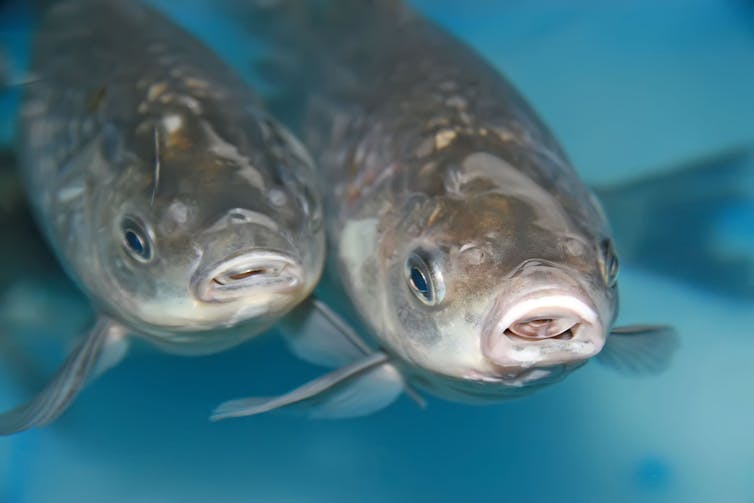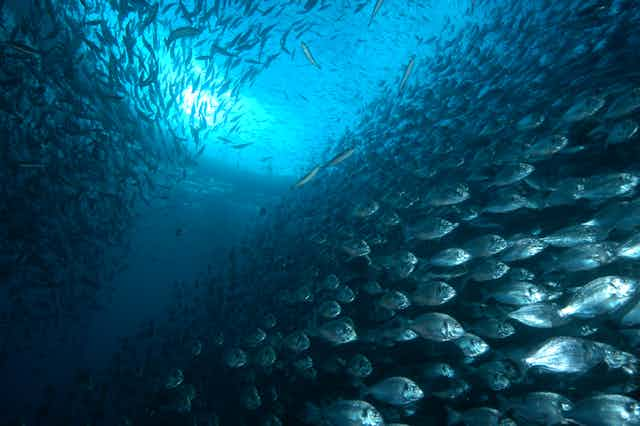The swift rise of aquaculture as a major supplier of protein to the world is a remarkable story of rapid domestication of marine and freshwater animals.
Just a few years ago, the world produced more tonnage of farmed fish than it did beef. With billions of farmed fish now in production systems, the lives fish lead and their welfare status have come under increasing scrutiny.
In this context, research we published this week has revealed that half of the world’s most farmed marine fish have a deformity that compromises one of their primary senses: hearing.
Hard of hearing
Salmon farming has been around since the 1970s, so it’s surprising to find a significant, widespread deformity today. Fish ear bones, or “otoliths”, are a cornerstone of fisheries science used to age wild fish and understand their movements in the environment. In farmed fish, age and origin are always known, so there has been no reason to look in depth at otoliths.
But we stumbled across a remarkable observation: farmed salmon seemed to have very high rates of otolith deformity.
The deformity occurs when the typical “aragonite” form of calcium carbonate in the otolith is replaced with a different crystal form, called “vaterite”. Otoliths with vaterite are larger, lighter and more brittle, and the way they perform within the ear changes.
Through a series of experiments and a model of fish hearing, we discovered that the vaterite deformity occurs at an early age. This happens most often when fish are in a hatchery, and its effects on hearing become increasingly more severe as the fish age. Fish afflicted with this deformity can lose up to 50% of their hearing sensitivity right across their hearing range.
More than a billion farmed salmon are harvested every year. To test if vaterite was a global phenomenon, we sampled salmon from the world’s major producers: Norway; Canada; Scotland; Chile; and Australia. Regardless of origin, the vaterite deformity was common.
Overall, farmed salmon were ten times more likely to have the deformity than wild fish. So there is a 50% chance that the last salmon you ate as sushi, smoked or cooked, didn’t hear so well.

So what?
These results raise questions about the welfare of farmed animals and could explain why some conservation programs don’t work.
Legislation to ensure the welfare of farmed animals in many countries is based on the “Five Freedoms”, which outline minimum requirements for farmed animals: freedom from hunger or thirst; freedom from discomfort; freedom from pain, injury or disease; freedom to express (most) normal behaviour; and freedom from fear and distress.
Producing farmed animals with deformities contravenes two of the “Five Freedoms”, specifically the freedom from pain, injury or disease and the freedom to express normal behaviour.
But we don’t yet know exactly how this hearing loss affects their life in farms. Fish farms are typically noisy environments, so some hearing loss may not necessarily be negative.
Deformed earbones could also explain why many fish conservation programs don’t always perform as expected.
Every year, billions of captive-bred juvenile salmon are released into rivers in North America, Asia and Europe to boost wild populations. But their survival is between ten and 20 times lower than that of wild salmon.
There are many theories about the causes of the poor performance of restocked fish, but now we must also consider that compromised hearing could be part of the problem. Hearing loss may prevent fish in the wild from detecting predators or finding prey, and could restrict their ability to navigate back to their home stream to breed.
All native fish re-stocking programs should now assess if their fish have deformed otoliths and what effect this has on their survival rates. If fish are routinely being produced with one of their five core senses compromised, we may just be throwing money and resources into the sea.
What next?
The next step is to work out why vaterite is so common in farmed fish. Something about the farming process is causing the deformity, but if we are to change how common it is, we need to know the root cause.
Life in a hatchery environment differs to life in the wild in many ways, and any one of these difference alone or together might be the culprit.
The key to reducing the incidence of vaterite earbones is prevention. Once the deformity has begun, it’s irreversible. If we can work out the root cause, past experience of addressing a range of deformities that have sprung up in aquaculture is good.

